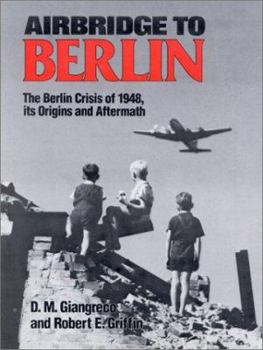Airbridge to Berlin: The Berlin Crisis of 1948, Its Origins and Aftermath
Forty years ago, on June 26, 1948, Soviet occupation forces closed all overland supply routes from the Western Zones of Occupation into Berlin. There was less than one month's supply of food on hand... This description may be from another edition of this product.
Format:Paperback
Language:English
ISBN:0891413294
ISBN13:9780891413295
Release Date:June 1988
Publisher:Presidio Press
Length:192 Pages
Weight:1.39 lbs.
Dimensions:0.6" x 8.6" x 11.0"
Customer Reviews
3 ratings
A complete description of the first allied victory in the Cold War
Published by Thriftbooks.com User , 17 years ago
The modern members of the Republican party are fond of saying that Ronald Reagan won the Cold War versus the Soviet Union. While he had a part in it, the major contributors to the American victory were Harry Truman and George Marshall. The first major battle of that war was "fought" in West Berlin in 1948. Once the war in Europe was over, the sometimes strained relationship between the Soviet Union and the western allies began to fall apart. While there had been agreement concerning zones of occupation in Germany, West Berlin immediately became a sticking point. The Soviets occupied the area known as East Berlin and each of the other main powers, the U.S. A., France and Great Britain, occupied sectors of what became West Berlin. Access to West Berlin was via land and air corridors across miles of East German territory. With very little productive capability, West Berlin was at the mercy of the level of shipments of vital goods from outside the city and that access was controlled by the communists. In 1948, the communists closed the land corridors to West Berlin in an attempt to "starve" the allies out. Rather than start a war or turn West Berlin over to the communists, the allies launched a massive airlift of supplies into the city. This was before the development of the jet airliner, so all goods were flown on propeller driven planes with a much smaller cargo capacity. The airlift was a resounding success and led to the first allied victory in the cold war. That victory also made it clear to the Europeans wavering in their opposition to the communists that the U. S. would do all it could short of war to defend them against that threat. It is no exaggeration to say that the cold war was won in Western Europe. Had the communists been able to take over West Berlin, it is likely that Greece and Italy would also have turned communist. As it was, it nearly happened in Greece. Stalin largely took a hands-off approach in the Greek civil war, had he won West Berlin, he might have been more forceful in supporting the Greek communists. His change in attitude and the perceived weakness of allied resolve could have turned the tide. This book is the best description of this turning point in the history of the world, while West Berlin was a relatively small piece of territory, it was hugely symbolic and this story of how it was saved is a historical treasure. The Berlin crisis was truly an inflection point in history and this book captures all the drama and circumstances back when the United States could truly do incredible things when it had to.
Solid Popular Account of the First Major Confrontation of the Cold War
Published by Thriftbooks.com User , 18 years ago
"Airbridge to Berlin" is one of many publications about the episode appearing as a result of 1988's fortieth anniversary of the Berlin Blockade and Airlift. This work presents the Berlin Blockade as a titanic struggle between two blocks of nations with divergent ideologies that nearly plunged the world into another major war. "Airbridge to Berlin" is designed exclusively as popular history, and does a fine job of offering a valuable reinterpretation of the event. Authors Giangreco and Griffin have succeeded admirably in presenting a graphic depiction of the airlift, this time from a decidedly American perspective. Their narrative concentrates on a description of the events of the airlift itself, the diplomatic story of its resolution, and a brief history of the city since 1949. They assert that no other city has been the center of East/West controversy as has Berlin in the post-World War II period. The blockade and airlift, Giangreco and Griffin suggest, was only one of several crises involving the city, and these confrontations will not abate until the unique situation of a divided Berlin is resolved. The most important contribution of "Airbridge to Berlin," however, is the more than 300 black and white photographs that illustrate the volume. Many have never been published before, and they depict well the trials and hopes of the people of Berlin during the blockade. The photographs put an entirely new face on the events of the Berlin Airlift and are alone worth the price of the volume.
Das Beste der Luftbrücke
Published by Thriftbooks.com User , 22 years ago
"The Chocolate Flyer" to the "Eye of the Storm," are far from the extent of information in this book. You are not thrown into the beginning of the airlift without any clue how you got there. The authors show you the "Road to Confrontation" from both the side of the Western Allies and of the UdSSR. The politics, economics and dynamics of the Berlin Blockade and Airlift are clarified with out the feel of a textbok. All together, it is quite enjoyable reading and filled with photographs and accounts of the actual people involved. The lives and hardships of the Berliners as well as the relationships formed between the pilots and the people give the book a realistic touch. No longer will the Berlin Crisis be just a page on the history books.





